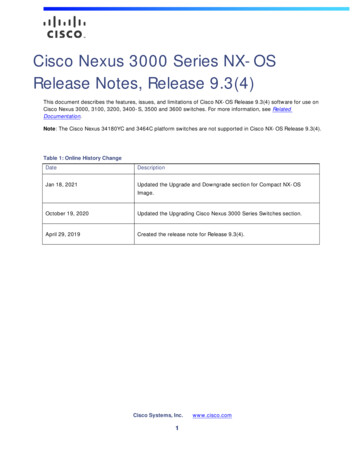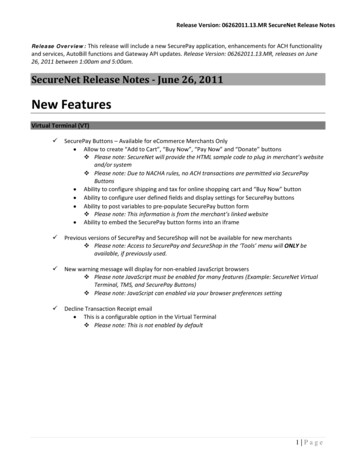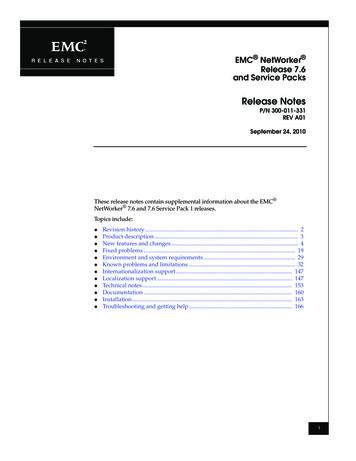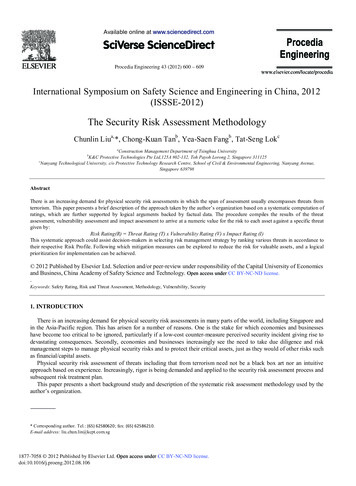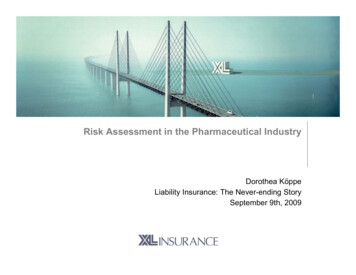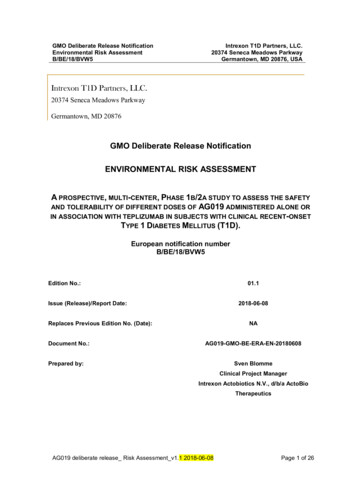
Transcription
GMO Deliberate Release NotificationEnvironmental Risk AssessmentB/BE/18/BVW5Intrexon T1D Partners, LLC.20374 Seneca Meadows ParkwayGermantown, MD 20876, USAIntrexon T1D Partners, LLC.20374 Seneca Meadows ParkwayGermantown, MD 20876GMO Deliberate Release NotificationENVIRONMENTAL RISK ASSESSMENTA PROSPECTIVE, MULTI-CENTER, PHASE 1B/2A STUDY TO ASSESS THE SAFETYAND TOLERABILITY OF DIFFERENT DOSES OF AG019 ADMINISTERED ALONE ORIN ASSOCIATION WITH TEPLIZUMAB IN SUBJECTS WITH CLINICAL RECENT-ONSETTYPE 1 DIABETES MELLITUS (T1D).European notification numberB/BE/18/BVW5Edition No.:01.1Issue (Release)/Report Date:2018-06-08Replaces Previous Edition No. (Date):Document No.:NAAG019-GMO-BE-ERA-EN-20180608Prepared by:Sven BlommeClinical Project ManagerIntrexon Actobiotics N.V., d/b/a ActoBioTherapeuticsAG019 deliberate release Risk Assessment v1.1 2018-06-08Page 1 of 26
GMO Deliberate Release NotificationEnvironmental Risk AssessmentB/BE/18/BVW5Intrexon T1D Partners, LLC.20374 Seneca Meadows ParkwayGermantown, MD 20876, USAGMO Deliberate Release Notification Part 3ENVIRONMENTAL RISK ASSESSMENTENVIRONMENTAL RISK ASSESSMENT CONCERNING THE DELIBERATERELEASE OF GENETICALLY MODIFIED ORGANISMS OTHER THAN HIGHERPLANTS1This environmental risk assessment is based on information provided in Part 1 A Technical Dossierand Part 1B Confidential Annexes.TABLE OF CONTENTSPageSTATEMENT OF DATA CONFIDENTIALITY CLAIM . 5I. THE ENVIRONMENTAL RISK ASSESSMENT . 6A. Identification of characteristics which may cause adverse effects . 61. Disease to humans including allergenic or toxic effects; . 62. Evaluation of the potential consequences of each adverse effect, if it occurs. . 103. Evaluation of the likelihood of the occurrence of each identified potential adverseeffect . 114. Estimation of the risk posed by each identified characteristic of the GMO(s) . 115. Application of management strategies for risks from the deliberate release ormarketing of GMO(s) . 126. Determination of the overall risk of the GMO(s) . 12B. Disease to animals and plants including toxic, and where appropriate, allergenic effects . 121. Identification of characteristics which may cause adverse effects: . 122. Evaluation of the potential consequences of each adverse effect, if it occurs . 133. Evaluation of the likelihood of the occurrence of each identified potential adverseeffect . 144. Estimation of the risk posed by each identified characteristic of the GMO(s) . 145. Application of management strategies for risks from the deliberate release ormarketing of GMO(s) . 146. Determination of the overall risk of the GMO(s) . 14C. Effects on the dynamics of populations of species in the receiving environment and thegenetic diversity of each of these populations; . 141. Identification of characteristics which may cause adverse effects: . 142. Evaluation of the potential consequences of each adverse effect, if it occurs . 153. Evaluation of the likelihood of the occurrence of each identified potential adverseeffect . 154. Estimation of the risk posed by each identified characteristic of the GMO(s) . 155. Application of management strategies for risks from the deliberate release ormarketing of GMO(s) . 166. Determination of the overall risk of the GMO(s) . 16D. Altered susceptibility to pathogens facilitating the dissemination of infectious diseasesand/or creating new reservoirs or vectors; . 161. Identification of characteristics which may cause adverse effects: . 162. Evaluation of the potential consequences of each adverse effect, if it occurs . 171according to annex II of the Royal Decree of 21 February 2005.on the deliberate release in the environment and theplacing on the market of genetically modified organisms or of products containing such organisms. (MB/BS - 24.02.2005 –p.7129)AG019 deliberate release Risk Assessment v1.1 08062018Page 2 of 26
GMO Deliberate Release NotificationEnvironmental Risk AssessmentB/BE/18/BVW5Intrexon T1D Partners, LLC.20374 Seneca Meadows ParkwayGermantown, MD 20876, USATABLE OF CONTENTSPage3. Evaluation of the likelihood of the occurrence of each identified potential adverseeffect . 174. Estimation of the risk posed by each identified characteristic of the GMO(s) . 185. Application of management strategies for risks from the deliberate release ormarketing of GMO(s) . 186. Determination of the overall risk of the GMO(s) . 18E. Compromising prophylactic or therapeutic medical, veterinary, or plant protectiontreatments, for example by transfer of genes conferring resistance to antibiotics used inhuman or veterinary medicine . 181. Identification of characteristics which may cause adverse effects: . 182. Evaluation of the potential consequences of each adverse effect, if it occurs . 193. Evaluation of the likelihood of the occurrence of each identified potential adverseeffect . 194. Estimation of the risk posed by each identified characteristic of the GMO(s) . 195. Application of management strategies for risks from the deliberate release ormarketing of GMO(s) . 196. Determination of the overall risk of the GMO(s) . 19F. Effects on biogeochemistry (biogeochemical cycles), particularly carbon and nitrogenrecycling through changes in soil decomposition of organic material. . 191. Identification of characteristics which may cause adverse effects: . 192. Evaluation of the potential consequences of each adverse effect, if it occurs . 203. Evaluation of the likelihood of the occurrence of each identified potential adverseeffect . 204. Estimation of the risk posed by each identified characteristic of the GMO(s) . 205. Application of management strategies for risks from the deliberate release ormarketing of GMO(s) . 206. Determination of the overall risk of the GMO(s) . 20II. CONCLUSIONS ON THE POTENTIAL ENVIRONMENTAL IMPACT FROM THE DELIBERATERELEASE OF GMOS . 21A. Likelihood of the GMO to become persistent and invasive in natural habitats under theconditions of the proposed release(s). . 21B. Any selective advantage or disadvantage conferred to the GMO and the likelihood ofthis becoming realised under the conditions of the proposed release(s). . 21C. Potential for gene transfer to other species under conditions of the proposed release ofthe GMO and any selective advantage or disadvantage conferred to those species. 22D. Potential immediate and/or delayed environmental impact of the direct and indirectinteractions between the GMO and target organisms (if applicable). . 22E. Potential immediate and/or delayed environmental impact of the direct and indirectinteractions between the GMO with non-target organisms, including impact onpopulation levels of competitors, prey, hosts, symbionts, predators, parasites andpathogens. . 22F. Possible immediate and/or delayed effects on human health resulting from potentialdirect and indirect interactions of the GMO and persons working with, coming intocontact with or in the vicinity of the GMO release(s). . 23G. Possible immediate and/or delayed effects on animal health and consequences for thefeed/food chain resulting from consumption of the GMO and any product derived fromit, if it is intended to be used as animal feed. . 23H. Possible immediate and/or delayed effects on biogeochemical processes resulting frompotential direct and indirect interactions of the GMO and target and non-targetorganisms in the vicinity of the GMO release(s). . 23I. Possible immediate and/or delayed, direct and indirect environmental impacts of thespecific techniques used for the management of the GMO where these are differentAG019 deliberate release Risk Assessment v1.1 08062018Page 3 of 26
GMO Deliberate Release NotificationEnvironmental Risk AssessmentB/BE/18/BVW5Intrexon T1D Partners, LLC.20374 Seneca Meadows ParkwayGermantown, MD 20876, USATABLE OF CONTENTSPagefrom those used for non-GMOs. . 23III. OVERALL CONCLUSIONS ON THE POTENTIAL ENVIRONMENTAL IMPACT FROM THEDELIBERATE RELEASE OF GMOS . 25BIBLIOGRAPHY REFERENCES . 26AG019 deliberate release Risk Assessment v1.1 08062018Page 4 of 26
GMO Deliberate Release NotificationEnvironmental Risk AssessmentB/BE/18/BVW5Intrexon T1D Partners, LLC.20374 Seneca Meadows ParkwayGermantown, MD 20876, USASTATEMENT OF DATA CONFIDENTIALITY CLAIMThis document is submitted by Intrexon T1D Partners, LLC. as part of a notification for a deliberaterelease of a GMO.The information in this document remains property of Intrexon T1D Partners, LLC. No part of thereport or any information contained herein may be used for any other purpose without prior writtenauthorization of Intrexon T1D Partners, LLC. or an affiliate thereof.AG019 deliberate release Risk Assessment v1.1 08062018Page 5 of 26
GMO Deliberate Release NotificationEnvironmental Risk AssessmentB/BE/18/BVW5Intrexon T1D Partners, LLC.20374 Seneca Meadows ParkwayGermantown, MD 20876, USAI. THE ENVIRONMENTAL RISK ASSESSMENTA.Identification of characteristics which may cause adverseeffects1. Disease to humans including allergenic or toxic effects;a.Evaluation of characteristics of the deliberate release leading to the potentialadverse effectsNeither Lactococcus lactis nor L. lactis sAGX0407 are hazardous.The GMO is a biologically contained strain of Lactococcus lactis. L. lactis iscommonly found in and added to food products. It is not classified as a hazardousorganism.Due to the nature of the IMP (i.e.; a live bacterium), there may be a risk for clinicallysignificant bacteremia or sepsis attributable to the sAGX0407 bacteria. However, it isimportant to keep in mind that: In the nonclinical studies, only negligible amounts of bacteria have beenfound in a few individual blood samples; further investigation suggested thatthis may have been due to the blood sampling method No clinical effects suggesting bacteremia or sepsis have been observed inany of the nonclinical studies An in vitro study performed with sAGX0407 confirmed that the bacteria areunable to survive in complement preserved human serum As part of the development of another ActoBiotics , IV inoculation of the L.lactis bacteria in neutropenic rats revealed that the bacteria were rapidlycleared, without any signs of sepsis. The antibiotics resistance profile of sAGX0407 was determined; in theunlikely event of bacteremia the bacteria can easily and quickly beinactivated by a broad range of commonly used antibioticsTherefore, the risk of clinically significant bacteremia or sepsis is considered to behighly unlikely.The only new proteins that are produced and secreted by the genetically modified L.lactis sAGX0407 are hIL-10 and hPINS.AG019 deliberate release Risk Assessment v1.1 08062018Page 6 of 26
GMO Deliberate Release NotificationEnvironmental Risk Assessmen
*02 'holehudwh 5hohdvh 1rwlilfdwlrq ,qwuh[rq 7 ' 3duwqhuv //& (qylurqphqwdo 5lvn vvhvvphqw 6hqhfd 0hdgrzv 3dunzd\ % %( %9: *hupdqwrzq 0' 86



